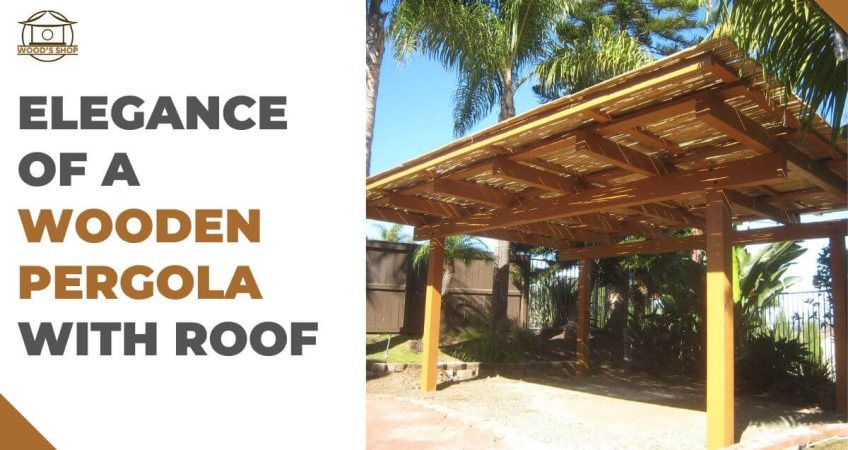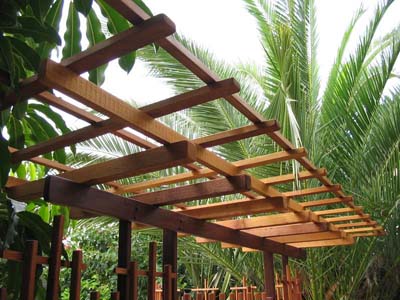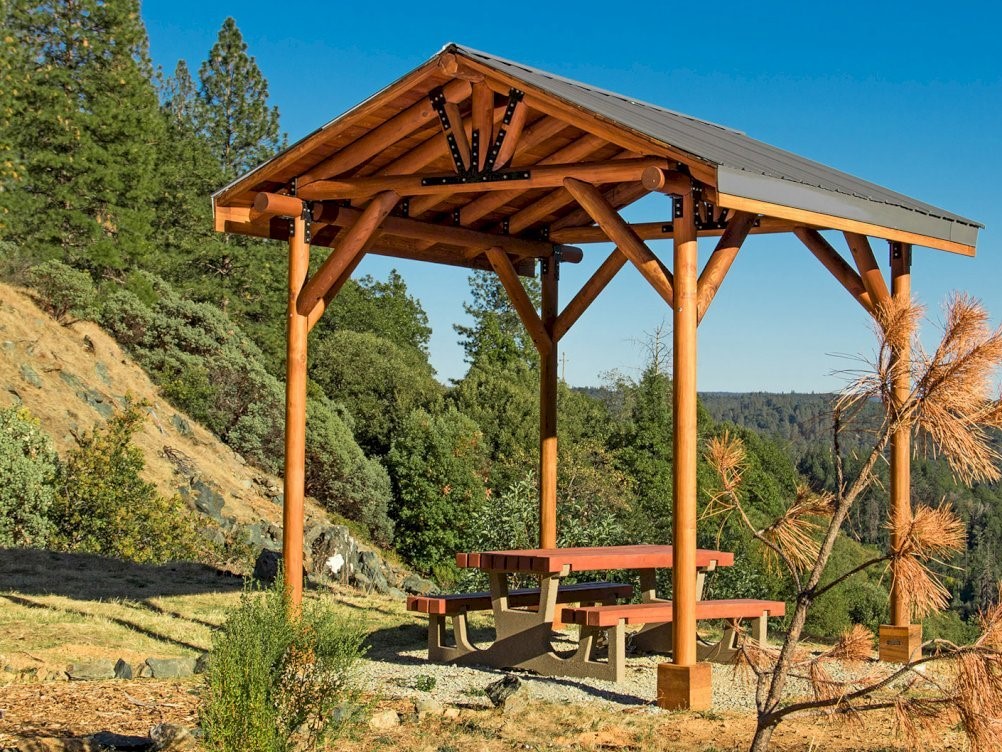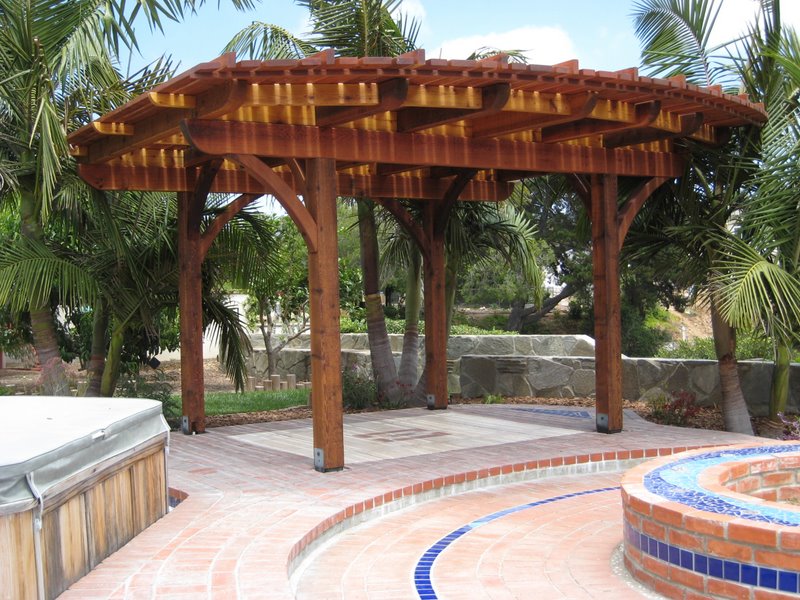Exploring the Elegance of a Wooden Pergola with Roof

A wooden pergola with a roof, often referred to as a ‘gazebo’, embodies the perfect blend of nature’s raw beauty and man-made architectural elegance. It is an outdoor structure, typically consisting of columns that support a roofing grid of beams and rafters.
This design not only provides shade but also adds an aesthetically pleasing element to your outdoor space. Over the years, this architectural feature has surged in popularity, becoming a sophisticated addition to gardens, patios, and decks. It offers a comfortable haven, merging the joy of outdoor living with the comfort and convenience of an indoor space.
Benefits of a Wooden Pergola with Roof
A wooden pergola with a roof brings a myriad of advantages to your outdoor area. Among these, the most remarkable one is its role in extending your living space. It provides a defined area for outdoor activities, creating a comfortable zone for dining, lounging, or entertaining, regardless of the weather conditions.
The structure’s roof adds an extra layer of protection against the elements, making it a suitable feature in regions with unpredictable weather patterns. Rain or shine, a pergola ensures your outdoor plans remain unaffected.
Moreover, the material – wood, in this case, offers a classic, timeless appeal that integrates seamlessly into various outdoor styles and landscapes. This adaptability allows homeowners to customize their pergola according to their preferences, enhancing the overall aesthetic of their outdoor space.
Lastly, a wooden pergola with a roof is not merely a decorative element. It adds value to your property, making it an attractive feature for potential buyers. Hence, a pergola is not just an investment in your lifestyle, but also a smart financial move.
Choosing the Right Wood
When choosing the right type of wood for your pergola, several options stand out due to their durability, appearance, and maintenance requirements.
Cedar is a popular choice for its natural resistance to rot, decay, and insect attacks, enhancing its longevity. Its beautiful, rich color adds a rustic charm to your outdoor space, and it requires minimal maintenance apart from occasional cleaning and sealing.
Redwood, another excellent option, is renowned for its striking appearance and resistance to warping and shrinking. While it is more expensive than cedar, the investment is often worth it for its enhanced durability and low maintenance requirements.
Teak is another high-end option that offers exceptional durability and an elegant look. It is highly resistant to environmental damage and requires minimal upkeep, but it comes with a steep price tag.
Pressure-treated pine is an economical choice, resistant to rot and insects due to the chemical treatments it undergoes. However, it requires more frequent maintenance, including regular painting or staining, to prevent warping and splitting.
Selecting the right wood for your pergola involves balancing durability, appearance, and maintenance requirements with your budget and personal preferences. By considering all these factors, you can create a beautiful, functional outdoor space that complements your lifestyle and enhances the value of your property.
Read More: Benefits of Having a Pergola in Your Backyard
Design Options
When it comes to the design of your wooden pergola with a roof, the possibilities are almost endless, ranging from traditional to modern styles. Traditional pergolas often feature intricate woodwork and carved details, providing a rustic or classical aesthetic that blends well with natural landscapes. They can be left in their natural wood color or stained for a more refined look.
Modern pergolas, on the other hand, are characterized by clean lines and minimalistic design. They often incorporate non-traditional materials such as metal or glass along with the wood, creating a sleek, contemporary look that pairs well with modern homes.
Regardless of the style you choose, customizing your pergola to match your individual preferences is key to creating an outdoor space that truly feels like an extension of your home. This can involve choices in color, finishes, size, roofing materials, and even the addition of extras like built-in seating, lighting, or planters.
As you consider the design options for your pergola, remember that the goal is to create a space that harmonizes with the rest of your home and outdoor space, while providing comfort and functionality. In doing so, your pergola will not only be a valuable addition to your property but also a cherished outdoor haven for years to come.
Roofing Materials
Deciding on the roofing material for your wooden pergola can significantly influence its aesthetic appeal, durability, and maintenance requirements. Here are a few commonly used options:
Polycarbonate Sheets: These are a popular choice for their durability, resistance to weather, and ability to filter UV rays while still letting light through. Available in a range of colors and transparency levels, they give homeowners the flexibility to control the amount of light and heat entering the pergola. However, they lack the natural appeal of other materials and can be more expensive.
Thatch: Thatch roofs lend a unique, rustic charm to your pergola, complementing a natural garden setting beautifully. They provide excellent insulation, keeping the pergola cool during summer and warm during winter. However, they may not be the best choice for areas with frequent rain or snow as they can retain moisture and decay over time.
Canvas: Canvas offers a more casual, flexible option for pergola roofing. It is typically less expensive and can be easily replaced or removed as needed. Canvas roofs are available in a variety of colors and patterns, allowing for more customization. However, they may not last as long as other materials and may require replacement every few years depending on their exposure to the elements.
Choosing the right roofing material for your pergola involves weighing the aesthetic appeal, durability, and maintenance requirements of each option against your budget, weather conditions, and personal preferences. By considering all these factors, you can enhance the functionality and appeal of your outdoor space, making your pergola a truly inviting haven.

Construction Process
Constructing a wooden pergola with a roof is an intricate process that requires careful planning and execution.
Creating a Solid Foundation
The first step is to create a solid foundation. To do this, you’ll need to dig post holes at the four corners of your pergola location. The depth and width of these holes will depend on the size of your pergola and local building codes. Once the holes are dug, you’ll place concrete footings in them. These footings will support the weight of the pergola and protect the wood from ground moisture.
Installing the Posts
Next, you install the posts. These will be secured into the footings and serve as the primary support structure for your pergola. The posts should be evenly spaced and perfectly vertical, ensuring stability and proper weight distribution.
Attaching the Beams and Rafters
Once the posts are installed, it’s time to attach the beams and rafters. Beams are horizontal pieces that connect the posts at the top, while rafters run perpendicular to the beams to form the roof structure.
Installing the Roof
Finally, you’ll install the roof. Depending on the roofing material you’ve chosen, this process will vary. For instance, if you’re using polycarbonate sheets, you’ll need to cut them to size and screw them into the rafters. If you’re using thatch, you’ll layer the material until you achieve the desired thickness and attach it securely to the rafters.
Finishing Touches
With the structure in place, you can add finishing touches like painting or staining the wood, installing lighting, or adding built-in seating.
Constructing a wooden pergola with a roof is a significant but rewarding DIY project. The key to success is thorough planning, careful execution, and a solid foundation. Remember to regularly maintain your pergola to keep it looking great and standing strong for years to come.

Maintenance and Care
Maintaining your pergola requires regular care and attention to ensure its longevity and keep it looking its best. Here are some helpful tips for taking care of both the wooden structure and the roof of your pergola:
Wood Maintenance: The wood of your pergola should be regularly treated to guard against rot, pests, and weather damage. Depending on the type of wood you’ve used, you might need to seal, paint, or stain it every couple of years. It’s also a good idea to periodically check for signs of decay or damage and to replace any affected parts promptly to prevent further deterioration.
Roof Care: The method for maintaining your pergola roof depends on the roofing material. Polycarbonate sheets should be regularly cleaned with warm soapy water to maintain their clarity and remove any debris. If your pergola has a thatch roof, be sure to inspect it regularly for signs of moisture retention or decay, and replace any damaged thatch as soon as possible. Canvas roofs may need to be taken down and laundered or replaced every few years, depending on the severity of the weather they’re exposed to.
Preventing damage is an integral part of pergola maintenance. If your pergola is situated under trees, regularly remove leaves and twigs from the roof to prevent rot and staining. In areas with heavy snowfall, brush off the snow after each snow event to prevent accumulation and excess weight on the structure. By committing to regular maintenance and care, you can extend the lifespan of your pergola and continue to enjoy it as a beautiful addition to your outdoor space for many years.
Read More: How to Maintain a Pergola (8 Best Tips)
Conclusion
A wooden pergola with a roof is more than just a functional structure; it is a transformative addition to any outdoor space. Offering an innate blend of nature and architecture, it enhances visual appeal while seamlessly integrating with the surroundings. Promoting outdoor living, these pergolas serve as an inviting space for relaxation, entertainment, or simply enjoying the beauty of nature.
With the right roofing material, your pergola can provide excellent protection against the elements and create a comfortable environment, regardless of the weather. It’s an investment that not only adds value to your property but also enriches your lifestyle, fostering memorable moments and connection with nature.
If you’re considering adding this beautiful feature to your home, Wood’s Shop offers a range of customizable options to meet your needs. Embark on this rewarding project and experience the joy of an elegant outdoor extension of your home.
Frequently Asked Questions
1. What are the maintenance requirements for a wooden pergola with a roof?
Regular care is essential to preserve the longevity and aesthetics of your pergola. Wood should be treated periodically to protect against weather damage and pests. The frequency of treatment depends on the type of wood used. The roof’s maintenance depends on the material – polycarbonate sheets should be cleaned regularly, and thatch roofs need to be checked for decay or moisture retention. Canvas roofs may need to be replaced every few years.
2. What are key considerations when choosing the roofing material for a pergola?
The selection of roofing material depends on various factors, such as budget, weather conditions, and personal aesthetic preferences. Durability, maintenance requirements, and the material’s ability to withstand exposure to elements are also significant considerations.
3. Can a pergola with a roof withstand heavy snowfall?
Yes, a well-constructed pergola with a roof can handle heavy snowfall. However, it’s advised to brush off the snow after each snow event to prevent accumulation and excess weight on the structure. Regular maintenance and checks for any signs of damage are also crucial.